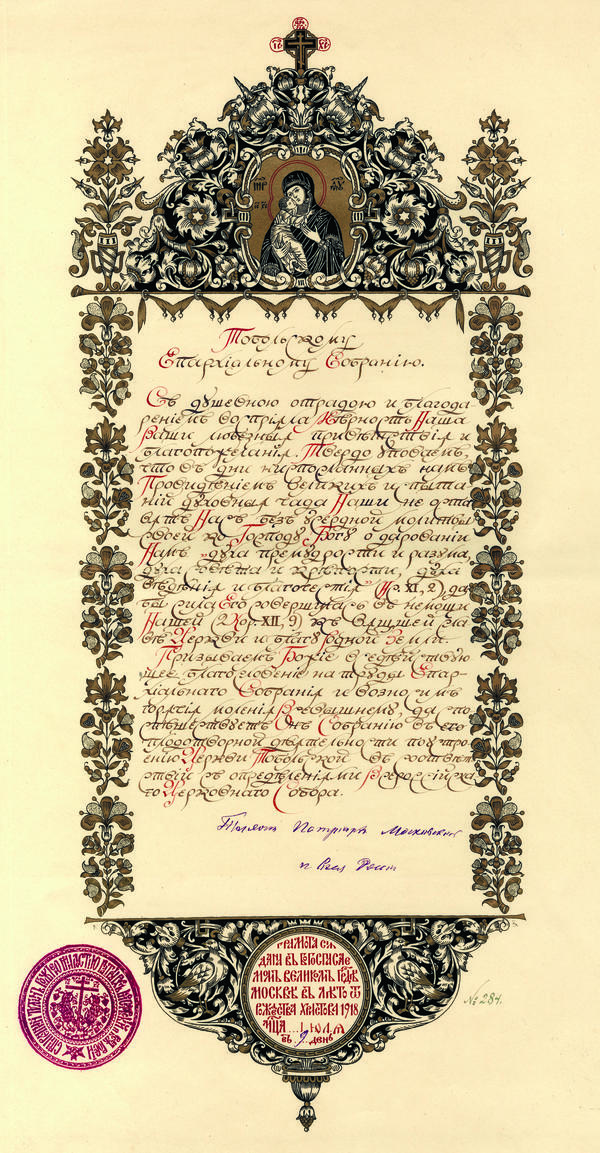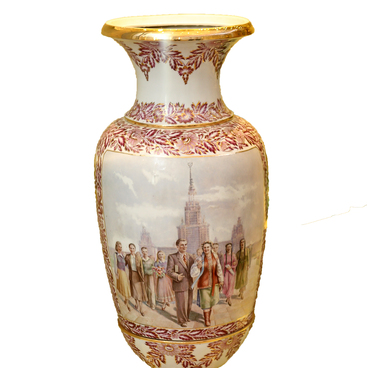Patriarch of Moscow and All Russia Tikhon (secular name Vasily Bellavin) was born in 1865 in the small town of Toropets in the Pskov province, in the family of a priest. In 1878 he graduated from the Toropets Theological School, and then the Pskov Theological Seminary, where he was considered one of the best students. Bellavin continued his studies at the Theological Academy of St. Petersburg. Peers nicknamed him ‘Patriarch’ because of his zeal for study and special reverence for the church.
In 1888, Bellavin became a teacher of theology at the Pskov Theological Seminary, and three years later, at the age of 26, he took the monastic vows under the name Tikhon. This decision surprised many friends of Bellavin, since he always seemed a secular person to them. Soon Tikhon was promoted to the rank of hierodeacon, then to the rank of hieromonk. In 1892, he was already rector of the Kholmsk Seminary.
In 1898 Tikhon was appointed Bishop of the Aleutian Islands and Alaska. At his suggestion, St. Nicholas Cathedral in Manhattan and several dozen churches in different cities were built, as well as the first monastery in North America. As the head of the Russian Mission, Tikhon facilitated opening of new schools and shelters. Under Tikhon, the bishop’s chair was transferred from San Francisco to New York, and many ecclesiastical texts were translated into English.
In 1907, Tikhon returned to Russia and was transferred to the Yaroslavl and Rostov Departments. In 1913, Tikhon was appointed Archbishop of Vilna and Lithuania. In August 1917, Tikhon was promoted to the rank of Metropolitan. After the revolution, when the All-Russian Local Council took the resolution to revive the Patriarchate in Russia, Tikhon was elected Patriarch of Moscow and All Russia.
The exposition contains Tikhon’s letter to the Tobolsk Diocesan Assembly of 1918. The Tobolsk diocese was one of the oldest Orthodox dioceses of Siberia, and after the revolution it was severely persecuted.
On April 15, 1918, a religious procession took place in Tobolsk, led by Bishop Hermogenes. He openly defended the canons of the Church and opposed the power of the Bolsheviks. For that, he was arrested and brutally killed.
This terrified all Orthodox believers of Tobolsk. It was after this event that Patriarch Tikhon addressed the diocesan assembly with words of blessing and ‘ardent prayers to the Almighty, and may He contribute to fruitful activity in setting up the Tobolsk church in accordance with the definitions of the All-Russian Church Council’.
In 1922, when the persecution of the Church reached enormous proportions, Patriarch Tikhon was indicted and imprisoned. However, soon the trial was canceled. According to one version, the reason for the cancellation was a note by George Curzon on behalf of the British Government. Among other things, Curzon demanded that the USSR stop the persecution of the church and the clergy.
Patriarch Tikhon died in 1925 at the age of 60. In 1981, Tikhon was canonized.
In 1888, Bellavin became a teacher of theology at the Pskov Theological Seminary, and three years later, at the age of 26, he took the monastic vows under the name Tikhon. This decision surprised many friends of Bellavin, since he always seemed a secular person to them. Soon Tikhon was promoted to the rank of hierodeacon, then to the rank of hieromonk. In 1892, he was already rector of the Kholmsk Seminary.
In 1898 Tikhon was appointed Bishop of the Aleutian Islands and Alaska. At his suggestion, St. Nicholas Cathedral in Manhattan and several dozen churches in different cities were built, as well as the first monastery in North America. As the head of the Russian Mission, Tikhon facilitated opening of new schools and shelters. Under Tikhon, the bishop’s chair was transferred from San Francisco to New York, and many ecclesiastical texts were translated into English.
In 1907, Tikhon returned to Russia and was transferred to the Yaroslavl and Rostov Departments. In 1913, Tikhon was appointed Archbishop of Vilna and Lithuania. In August 1917, Tikhon was promoted to the rank of Metropolitan. After the revolution, when the All-Russian Local Council took the resolution to revive the Patriarchate in Russia, Tikhon was elected Patriarch of Moscow and All Russia.
The exposition contains Tikhon’s letter to the Tobolsk Diocesan Assembly of 1918. The Tobolsk diocese was one of the oldest Orthodox dioceses of Siberia, and after the revolution it was severely persecuted.
On April 15, 1918, a religious procession took place in Tobolsk, led by Bishop Hermogenes. He openly defended the canons of the Church and opposed the power of the Bolsheviks. For that, he was arrested and brutally killed.
This terrified all Orthodox believers of Tobolsk. It was after this event that Patriarch Tikhon addressed the diocesan assembly with words of blessing and ‘ardent prayers to the Almighty, and may He contribute to fruitful activity in setting up the Tobolsk church in accordance with the definitions of the All-Russian Church Council’.
In 1922, when the persecution of the Church reached enormous proportions, Patriarch Tikhon was indicted and imprisoned. However, soon the trial was canceled. According to one version, the reason for the cancellation was a note by George Curzon on behalf of the British Government. Among other things, Curzon demanded that the USSR stop the persecution of the church and the clergy.
Patriarch Tikhon died in 1925 at the age of 60. In 1981, Tikhon was canonized.



